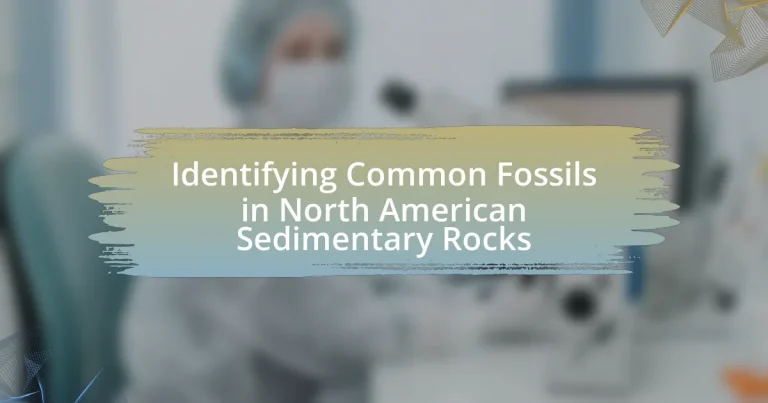The article focuses on identifying common fossils found in North American sedimentary rocks, including trilobites, brachiopods, bivalves, ammonites, and corals. It explains the fossilization process, detailing how burial, compaction, and mineralization contribute to fossil preservation in sedimentary environments. The significance of these fossils in understanding geological history, biological evolution, and resource exploration is highlighted, along with methods for field identification and responsible fossil collection practices. Additionally, the article provides resources for further learning and emphasizes the role of local museums in enhancing fossil identification skills.

What are Common Fossils Found in North American Sedimentary Rocks?
Common fossils found in North American sedimentary rocks include trilobites, brachiopods, bivalves, ammonites, and corals. Trilobites, which are extinct marine arthropods, are frequently discovered in Cambrian and Ordovician rocks, showcasing their widespread presence during the Paleozoic era. Brachiopods and bivalves, both types of shellfish, are abundant in various sedimentary layers, particularly in the Paleozoic and Mesozoic eras, indicating diverse marine environments. Ammonites, known for their spiral shells, are prevalent in Mesozoic deposits and serve as important index fossils for dating geological strata. Corals, which contribute to reef-building, are commonly found in limestone formations, reflecting ancient marine ecosystems. These fossils provide critical insights into the geological history and past environments of North America.
How do these fossils form within sedimentary environments?
Fossils form within sedimentary environments through a process called fossilization, which typically involves the burial of organic material under layers of sediment. When organisms die, their remains can be quickly covered by sediment, such as mud or sand, which protects them from decay and scavengers. Over time, additional layers of sediment accumulate, applying pressure that leads to the compaction and cementation of the sediments, preserving the shape and structure of the original organisms. This process can take thousands to millions of years, resulting in the formation of fossils that can be identified in North American sedimentary rocks, such as limestone and shale, where conditions favor fossil preservation.
What processes contribute to fossilization in sedimentary rocks?
Fossilization in sedimentary rocks primarily occurs through processes such as burial, compaction, and mineralization. Burial involves the accumulation of sediment over organic remains, which protects them from decay. Compaction occurs as layers of sediment build up, increasing pressure and reducing pore space, which aids in preserving the remains. Mineralization, or permineralization, happens when minerals carried by water fill the spaces within organic material, turning it into stone-like fossils. These processes are essential for creating fossils, as they facilitate the preservation of biological material over geological time.
How do sedimentary conditions affect fossil preservation?
Sedimentary conditions significantly influence fossil preservation by determining the environment in which organisms are buried and the rate of decomposition. For instance, rapid burial in anoxic (low-oxygen) environments, such as deep-sea sediments or lake beds, reduces decay and enhances preservation, as evidenced by the exceptional fossil records found in the Burgess Shale, where fine-grained sediments created ideal conditions for fossilization. Conversely, in high-energy environments like riverbanks or shorelines, fossils are often destroyed due to erosion and disturbance, leading to poorer preservation outcomes. Thus, the type of sediment, its grain size, and the energy of the depositional environment are critical factors that dictate the likelihood of fossil preservation.
Why is it important to identify these fossils?
Identifying fossils is crucial for understanding the geological history and biological evolution of Earth. Fossils provide evidence of past life forms, their environments, and the changes that have occurred over millions of years. For instance, the identification of trilobite fossils in North American sedimentary rocks helps paleontologists date the rock layers and reconstruct ancient ecosystems, revealing how life adapted to changing conditions. This process is supported by the principle of faunal succession, which states that specific fossil assemblages correspond to particular geological time periods, allowing scientists to correlate rock layers across different regions.
What role do fossils play in understanding geological history?
Fossils play a crucial role in understanding geological history by providing evidence of past life forms and their environments. They allow scientists to reconstruct ancient ecosystems, track evolutionary changes, and date geological layers through biostratigraphy. For instance, the presence of specific fossils, such as trilobites or ammonites, can indicate the age of sedimentary rock layers, as these organisms existed during particular geological periods. This correlation helps establish a timeline of Earth’s history and the changes in climate and geography over millions of years.
How can fossil identification aid in resource exploration?
Fossil identification aids in resource exploration by providing critical insights into the geological history and depositional environments of sedimentary rocks. By analyzing the types of fossils present, geologists can infer the age of the rock layers and the conditions under which they were formed, which is essential for locating hydrocarbons and other natural resources. For instance, the presence of specific fossilized organisms, such as ammonites or trilobites, can indicate the presence of oil-rich source rocks, as these organisms thrived in marine environments conducive to hydrocarbon formation. Additionally, fossil assemblages can help identify potential reservoirs and seal rocks, guiding exploration efforts more effectively.

What Types of Fossils are Commonly Found?
Commonly found fossils include ammonites, trilobites, brachiopods, and bivalves. Ammonites, which are extinct marine mollusks, are frequently discovered in North American sedimentary rocks, particularly in Cretaceous deposits. Trilobites, ancient arthropods, are often found in Paleozoic strata, showcasing a wide variety of species. Brachiopods, marine animals with hard shells, are prevalent in both Paleozoic and Mesozoic rocks, while bivalves, such as clams and oysters, are commonly found in various sedimentary environments. These fossil types provide significant insights into the geological history and past ecosystems of North America.
Which invertebrate fossils are prevalent in North American sedimentary rocks?
Invertebrate fossils prevalent in North American sedimentary rocks include trilobites, brachiopods, mollusks, and echinoderms. Trilobites, which thrived during the Paleozoic Era, are commonly found in Cambrian and Ordovician rocks. Brachiopods, marine animals with hard shells, are abundant in Devonian and Carboniferous deposits. Mollusks, including bivalves and gastropods, are widespread in various sedimentary layers, particularly from the Mesozoic Era. Echinoderms, such as crinoids, are also frequently discovered in sedimentary formations, especially from the Paleozoic. These fossils provide critical insights into the ancient marine environments of North America.
What are the characteristics of trilobites found in these rocks?
Trilobites found in North American sedimentary rocks exhibit distinct characteristics such as a segmented body, a hard exoskeleton, and a three-lobed structure. These marine arthropods typically possess a cephalon (head), a thorax with multiple segments, and a pygidium (tail), which are key features for identification. Fossil evidence shows that trilobites varied in size, ranging from a few millimeters to over 70 centimeters, and displayed diverse morphologies adapted to different ecological niches. Their fossils are often well-preserved in sedimentary rock layers, providing insights into their evolutionary history and the paleoenvironment.
How do brachiopods differ from bivalves in fossil records?
Brachiopods differ from bivalves in fossil records primarily in their shell structure and symmetry. Brachiopods possess two shells (valves) that are not symmetrical, with one valve typically larger than the other, while bivalves have two symmetrical shells that are mirror images of each other. Fossil evidence shows that brachiopods were more abundant in Paleozoic eras, particularly during the Cambrian and Ordovician periods, whereas bivalves became more dominant in the Mesozoic era. This distinction is supported by the prevalence of brachiopod fossils in older sedimentary rock layers compared to the increased occurrence of bivalve fossils in younger strata, indicating a shift in marine ecosystems over geological time.
What vertebrate fossils can be identified in these formations?
Vertebrate fossils identified in North American sedimentary rock formations include dinosaurs, marine reptiles, early mammals, and fish. For instance, the Late Cretaceous formations are known for fossils of Tyrannosaurus rex and Triceratops, while the Jurassic formations often yield fossils of marine reptiles like Plesiosaurus and Ichthyosaurus. Additionally, the fossil record from the Paleocene epoch reveals early mammalian species such as Didelphodon. These findings are supported by extensive paleontological studies that document the diversity of vertebrate life in these geological periods.
What are the key features of dinosaur fossils in North America?
The key features of dinosaur fossils in North America include diverse species representation, well-preserved skeletal remains, and significant geological context. North America has yielded fossils from various dinosaur groups, such as theropods, sauropods, and ornithischians, with notable sites like the Hell Creek Formation and the Morrison Formation providing rich deposits. These fossils often exhibit excellent preservation due to sedimentary rock formations that facilitate fossilization, allowing for detailed study of morphology and behavior. Additionally, the geological context, including the age of the rock layers, helps paleontologists understand the environmental conditions during the dinosaurs’ existence, further validating the significance of these fossils in reconstructing prehistoric ecosystems.
How do marine reptiles contribute to the fossil record?
Marine reptiles contribute to the fossil record by providing significant evidence of prehistoric life in aquatic environments. Their fossils, including bones, teeth, and sometimes soft tissues, help scientists understand the diversity, evolution, and ecological roles of these creatures during the Mesozoic era. For instance, the discovery of ichthyosaur and plesiosaur fossils in North American sedimentary rocks reveals insights into their adaptations to marine life and their distribution across ancient oceans. These findings are crucial for reconstructing past ecosystems and understanding the evolutionary history of reptiles.

How Can Fossils be Identified in the Field?
Fossils can be identified in the field by examining their physical characteristics, such as shape, size, and texture, as well as their location within sedimentary rock layers. Field identification involves recognizing specific features like the presence of shells, bones, or imprints that indicate biological origin. For instance, trilobite fossils can be identified by their distinct segmented bodies and compound eyes, while ammonites are recognized by their coiled shells and intricate suture patterns. Additionally, the stratigraphic context, including the type of sedimentary rock and its age, provides crucial information for accurate identification, as certain fossils are characteristic of specific geological periods. This method of identification is supported by paleontological studies that correlate fossil types with their respective strata, enhancing the reliability of field identification techniques.
What tools and techniques are essential for fossil identification?
Essential tools and techniques for fossil identification include hand lenses, hammers, chisels, and field guides. Hand lenses allow for close examination of fossil details, while hammers and chisels are used to extract fossils from rock. Field guides provide crucial information on fossil types and their geological contexts, aiding in accurate identification. Additionally, techniques such as stratigraphic analysis and radiometric dating help determine the age and environmental conditions of the fossils, enhancing the identification process.
How can field guides assist in recognizing common fossils?
Field guides assist in recognizing common fossils by providing detailed descriptions, illustrations, and identification keys specific to various fossil types found in North American sedimentary rocks. These guides often include information on the geological context, stratigraphy, and age of the fossils, which helps users accurately identify specimens in the field. For example, a field guide may feature images of common fossils like trilobites or ammonites alongside descriptions of their distinguishing features, habitat, and associated rock formations, enabling effective identification and understanding of fossil diversity.
What role does photography play in documenting fossil finds?
Photography plays a crucial role in documenting fossil finds by providing a visual record that captures the details and context of the fossils. This visual documentation aids in the identification and analysis of fossils, allowing researchers to share findings with the scientific community and the public. High-quality photographs can reveal important features such as size, shape, and surface texture, which are essential for accurate classification. Additionally, photographs can serve as a reference for future studies, enabling comparisons over time and across different locations. The use of photography in fossil documentation is supported by its ability to enhance communication and collaboration among paleontologists, as evidenced by numerous studies that emphasize the importance of visual data in scientific research.
What are the best practices for collecting fossils responsibly?
The best practices for collecting fossils responsibly include obtaining permission from landowners, following local laws and regulations, and minimizing environmental impact. Collectors should research the area to understand its geological significance and ensure that fossil collection does not disturb ecosystems or archaeological sites. Additionally, using proper tools and techniques helps preserve the integrity of fossils and surrounding sediment. Responsible collectors also document their finds with precise location data, which contributes to scientific knowledge and helps maintain the context of the fossils.
How can collectors ensure they follow legal and ethical guidelines?
Collectors can ensure they follow legal and ethical guidelines by researching and adhering to local, state, and federal laws regarding fossil collection. For instance, the Federal Land Policy and Management Act prohibits unauthorized collection of fossils on public lands, and many states have specific regulations governing fossil hunting. Additionally, collectors should obtain necessary permits and respect private property rights, as collecting without permission can lead to legal repercussions. Ethical practices also include documenting the provenance of fossils and sharing findings with scientific communities, which promotes responsible stewardship of natural resources.
What steps should be taken to preserve fossils after collection?
To preserve fossils after collection, the first step is to clean the fossils gently using a soft brush to remove any dirt or debris. Following this, fossils should be dried thoroughly to prevent moisture-related damage. Next, they should be stored in a stable environment with controlled temperature and humidity levels, ideally in acid-free boxes or containers to avoid chemical reactions that could degrade the fossils. Additionally, labeling each fossil with relevant information, such as location and date of collection, is crucial for future reference. These steps are supported by best practices in paleontology, which emphasize the importance of proper handling and storage to maintain fossil integrity over time.
What Resources are Available for Further Learning?
Resources available for further learning about identifying common fossils in North American sedimentary rocks include academic textbooks, online courses, and field guides. Textbooks such as “Fossils: A Very Short Introduction” by David Norman provide foundational knowledge on fossil identification and paleontology. Online platforms like Coursera and edX offer courses on paleobiology and geology, allowing learners to explore fossil identification techniques in depth. Additionally, field guides like “Fossils of North America” by Richard A. Fortey serve as practical references for identifying specific fossils in the field. These resources collectively enhance understanding and skills in fossil identification.
Which online databases provide information on North American fossils?
The online databases that provide information on North American fossils include the Paleobiology Database, Fossilworks, and the National Park Service’s Geology Resources Division. The Paleobiology Database is a comprehensive resource that aggregates fossil data from various sources, allowing users to search for fossils by location and time period. Fossilworks offers tools for analyzing fossil occurrences and provides access to the Paleobiology Database. The National Park Service’s Geology Resources Division includes information on fossils found in national parks, enhancing public understanding of paleontological resources. These databases are widely recognized for their accuracy and extensive collections, making them valuable for researchers and enthusiasts alike.
How can local museums enhance fossil identification skills?
Local museums can enhance fossil identification skills by providing hands-on workshops and interactive exhibits that focus on fossil recognition techniques. These educational programs allow participants to engage directly with fossil specimens, facilitating a deeper understanding of morphological features and classification methods. For instance, museums can offer guided sessions where experts demonstrate the identification of common fossils found in North American sedimentary rocks, such as trilobites and ammonites, using real examples. Additionally, access to curated collections and educational resources, including field guides and identification keys, supports self-directed learning and reinforces skills acquired during workshops.





